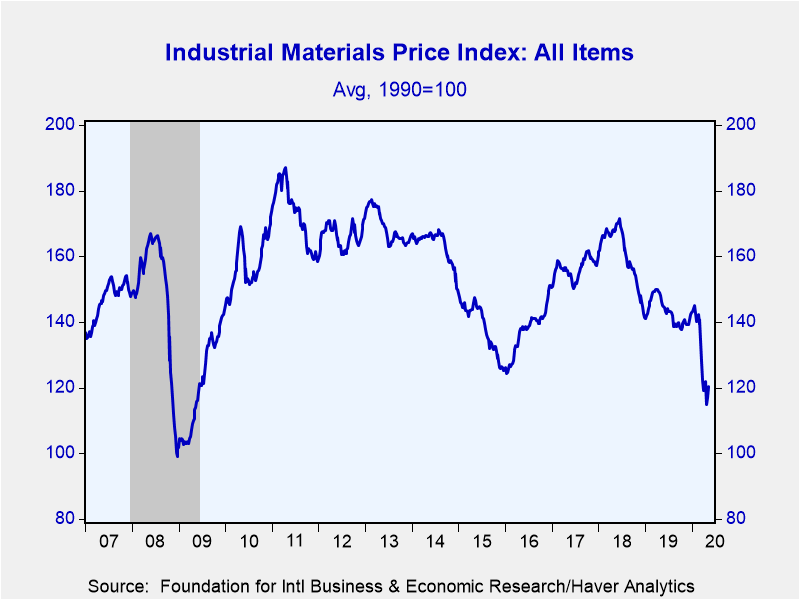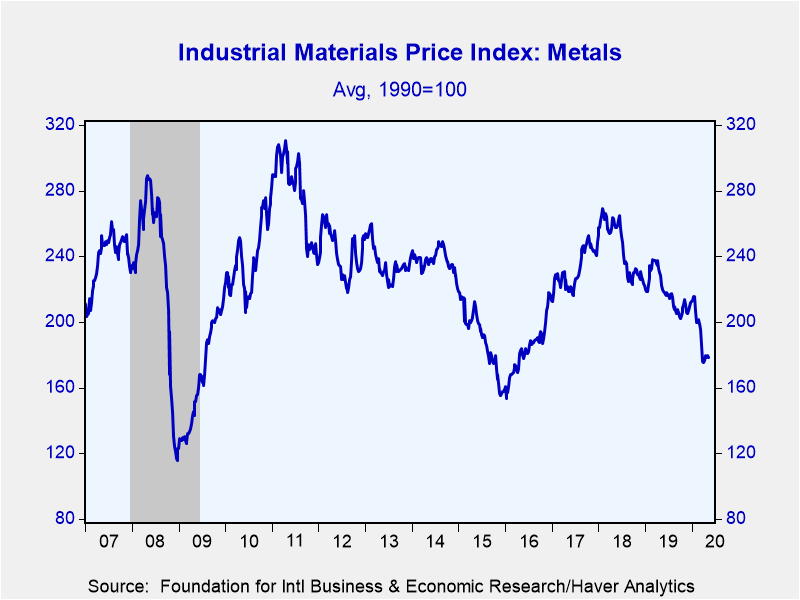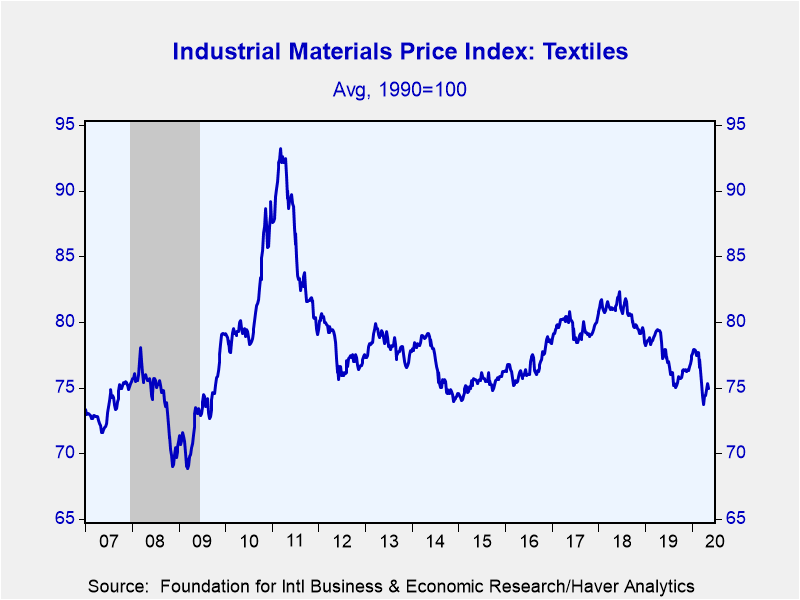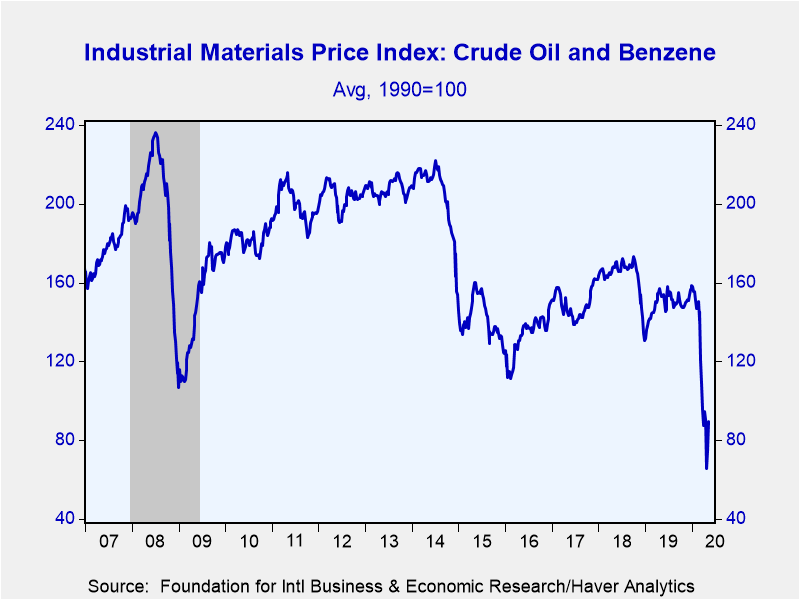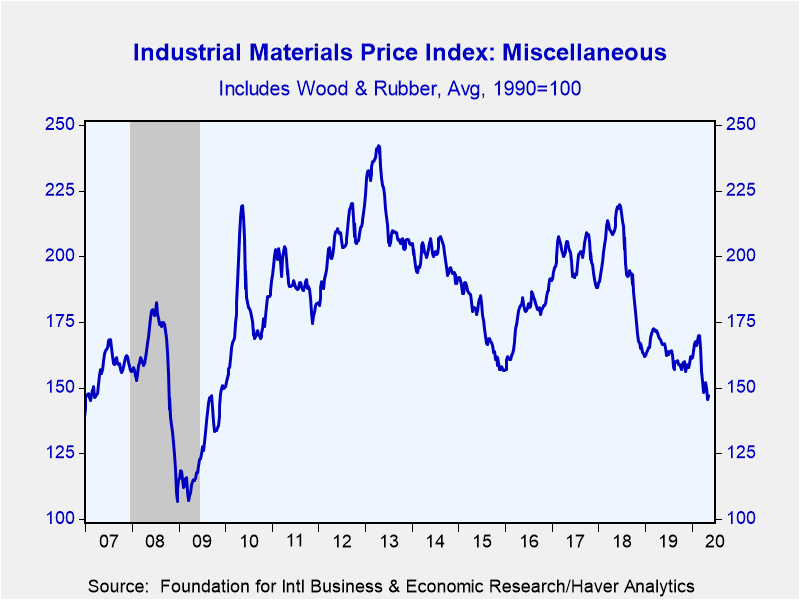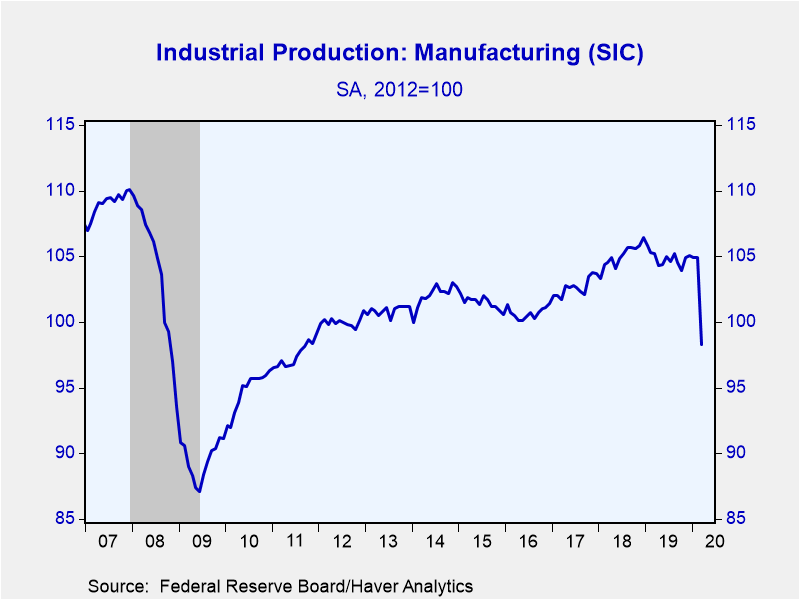 Global| May 11 2020
Global| May 11 2020FIBER: Industrial Commodity Price Declines Stabilize
by:Tom Moeller
|in:Economy in Brief
Summary
The Industrial Materials Price Index from the Foundation for International Business and Economic Research (FIBER) fell 0.8% during the four weeks ended Friday. The price index has moved irregularly sideways for the last six weeks but [...]
The Industrial Materials Price Index from the Foundation for International Business and Economic Research (FIBER) fell 0.8% during the four weeks ended Friday. The price index has moved irregularly sideways for the last six weeks but remained 17.7% lower than twelve months earlier.
Prices in the metals group improved 1.0% during the last four weeks as the cost of copper scrap rose 3.7% and zinc prices increased 2.1% (-31.5% y/y). Steel scrap prices edged 0.9% higher and aluminum prices gained 0.4%. To the downside, lead prices fell 4.1% (-14.0% y/y) in the last four weeks. Also improving by 0.7% were prices in the textile group. Cotton prices surged 4.5% but the cost of burlap held steady (1.7% y/y).
Continuing to work lower were prices in the crude oil & benzene group which fell 5.6% in the last four weeks as WTI crude oil prices weakened to $22.74 per barrel, down from a high of $61.92 in the first week of January. Prices remained near the lowest level since early-2002. Prices of the petro-chemical benzene fell 5.4% in the last four weeks (-56.5% y/y). Excluding crude oil, industrial commodity prices eased 0.1% during the last four weeks and were off 13.6% over the last year. Prices in the miscellaneous group declined 1.3% as hide prices fell by one-third (-43.9% y/y). Plywood prices continued to hold steady but were down 7.9% y/y. Framing lumber prices rose 14.4% in the last four weeks and the price of natural rubber improved 1.9%.
A struggling U.S. factory sector holds little promise for improvement in industrial materials prices. Industrial output plummeted 6.3% in March (-6.6% y/y) as the effects of the coronavirus started to be felt. During the last ten years, there has been a 57% correlation between the y/y change in industrial commodity prices and the y/y change in factory sector production.
Commodity price data can be found in Haver's DAILY, WEEKLY, USECON and CMDTY databases. The NABE forecast is in the SURVEYS database.
| FIBER Industrial Materials Price Index (%) | 1-Mth | 3-Mth | 6-Mth | 12-Mth | 2019 | 2018 | 2017 |
|---|---|---|---|---|---|---|---|
| All Items | -0.8 | -14.3 | -14.6 | -17.7 | 1.1 | -12.0 | 6.7 |
| Excluding Crude Oil | -0.1 | -10.8 | -10.6 | -13.6 | -0.6 | -11.1 | 4.9 |
| Textiles | 0.7 | -3.2 | -1.8 | -4.5 | -1.6 | -2.8 | 3.0 |
| Cotton (cents per pound) | 4.5 | -20.6 | -18.1 | -26.0 | -6.6 | -9.2 | 9.8 |
| Metals | 1.0 | -10.7 | -16.6 | -19.8 | -4.3 | -12.2 | 18.6 |
| Aluminum ($ per metric ton) | 0.4 | -14.9 | -19.9 | -18.6 | -6.5 | -12.7 | 26.0 |
| Copper Scrap (cents per pound) | 3.7 | -9.2 | -12.6 | -16.5 | 3.5 | -16.1 | 29.3 |
| Steel Scrap ($ per ton) | 0.9 | -7.3 | -7.9 | -17.8 | -0.8 | 2.3 | 16.8 |
| Crude Oil & Benzene | -5.6 | -39.2 | -39.9 | -41.6 | 20.2 | -20.0 | 8.1 |
| Crude Oil (WTI, $ per Barrel) | -11.7 | -55.6 | -59.8 | -63.3 | 35.5 | -24.4 | 10.9 |
| Miscellaneous | -1.3 | -11.6 | -8.1 | -12.1 | -0.0 | -14.8 | -0.5 |
| Framing Lumber ($ per 1000 board ft.) | 14.4 | -22.4 | -17.0 | -7.6 | 22.6 | -23.1 | 20.0 |
| Natural Rubber (cents per pound) | 1.9 | -3.9 | -1.7 | -15.2 | 10.7 | -4.1 | -29.6 |
Tom Moeller
AuthorMore in Author Profile »Prior to joining Haver Analytics in 2000, Mr. Moeller worked as the Economist at Chancellor Capital Management from 1985 to 1999. There, he developed comprehensive economic forecasts and interpreted economic data for equity and fixed income portfolio managers. Also at Chancellor, Mr. Moeller worked as an equity analyst and was responsible for researching and rating companies in the economically sensitive automobile and housing industries for investment in Chancellor’s equity portfolio. Prior to joining Chancellor, Mr. Moeller was an Economist at Citibank from 1979 to 1984. He also analyzed pricing behavior in the metals industry for the Council on Wage and Price Stability in Washington, D.C. In 1999, Mr. Moeller received the award for most accurate forecast from the Forecasters' Club of New York. From 1990 to 1992 he was President of the New York Association for Business Economists. Mr. Moeller earned an M.B.A. in Finance from Fordham University, where he graduated in 1987. He holds a Bachelor of Arts in Economics from George Washington University.


